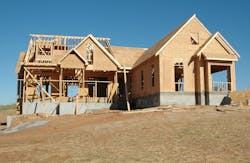Housing Affordability Holds Steady; Challenges Loom
Record-low mortgage rates offset record-high home prices to keep housing affordability steady in the fourth quarter of 2020, according to the National Association of Home Builders (NAHB)/Wells Fargo Housing Opportunity Index (HOI) released today. Though affordability rates held firm, regulatory and supply-side challenges threaten to aggravate affordability problems in the year ahead.
In all, 58.3 percent of new and existing homes sold between the beginning of October and end of December were affordable to families earning an adjusted U.S. median income of $72,900. This is unchanged from the 58.3 homes sold in the third quarter of 2020 that were affordable to median-income earners and the lowest reading since the fourth quarter of 2018.
“While historically low mortgage rates are helping on the affordability front, there was a significant jump in year-over-year home pricing from 2020 to 2019, as inventory remained lean due to supply chain issues and the COVID-19 pandemic,” said NAHB Chairman Chuck Fowke, a custom home builder from Tampa, Fla. “Moreover, lumber prices remain extremely high and builders anticipate that regulatory costs are likely to rise, which will put even more upward pressure on home prices.”
“Looking forward, interest rates are likely to rise as the pace of vaccines increase and economic activity climbs back to more normal levels,” said NAHB Chief Economist Robert Dietz. “One trend that will help counterbalance growing affordability concerns is the suburban shift in home sales and construction to smaller markets. An increase in telecommuting is providing more ‘market power’ to prospective buyers, allowing them to live in lower cost, lower density markets.”
The HOI shows that the national median home price jumped to an all-time high of $320,000 in the fourth quarter, surpassing the previous record-high of $313,000 set in the third quarter. Meanwhile, average mortgage rates fell by 20 basis points in the fourth quarter to a record-low of 2.85 percent from the previous all-time low of 3.05 percent in the third quarter.
Lansing-East Lansing, Mich., was the nation’s most affordable major housing market, defined as a metro with a population of at least 500,000. In Lansing-East Lansing, 89.9 percent of all new and existing homes sold in the fourth quarter were affordable to families earning the area’s median income of $75,000.
Rounding out the top five affordable major housing markets in respective order were Harrisburg-Carlisle, Pa.; Pittsburgh, Pa.; Scranton-Wilkes-Barre-Hazleton, Pa.; and St. Louis, Mo.
Meanwhile, Cumberland-Md.-W.Va., was rated the nation’s most affordable smaller market, with 96.4 percent of homes sold in the fourth quarter being affordable to families earning the median income of $57,500. Smaller markets joining Cumberland at the top of the list included Kokomo, Ind.; Wheeling, W.Va.-Ohio (tied for second); Binghamton, N.Y.; and Mankato-North Mankato, Minn.
Los Angeles-Long Beach-Glendale, Calif., supplanted San Francisco-Redwood City-South San Francisco, Calif., as the nation’s least affordable major housing market. There, just 9.1 percent of the homes sold during the fourth quarter were affordable to families earning the area’s median income of $71,800.
Other major metros at the bottom of the affordability chart were in California. In descending order, they included San Francisco-Redwood City-South San Francisco; Anaheim-Santa Ana-Irvine; San Diego-Carlsbad; and San Jose-Sunnyvale-Santa Clara.
All five least affordable small housing markets were also in the Golden State. At the very bottom of the affordability chart was Salinas, where 13.6 percent of all new and existing homes sold in the fourth quarter were affordable to families earning the area’s median income of $75,800.
In descending order, other small markets at the lowest end of the affordability scale included Santa Maria-Santa Barbara; Santa Cruz-Watsonville (tied for second); Merced; and San Luis Obispo-Paso Robles-Arroyo Grande.
Please visit nahb.org/hoi for tables, historic data and details.
